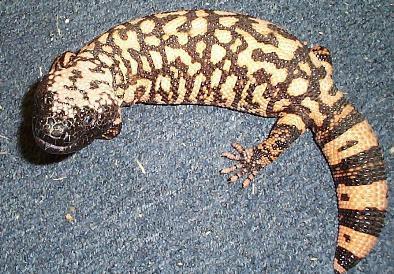


|
Helodermatidae:
The family Helodermatidae consists of only two species: Heloderma suspectum and H. horridum are the only venomous lizards. Their bite is painful, but seldom fatal to man.
The helodermatids are heavy-bodied, short-tailed, clumsy-looking lizards, gaudily marked with dark reticulations on a yellow or orange background, or vice versa.There are a few palatine and pterygoid teeth, no temporal arches, and eight cervical vertebrae. The back and other surfaces of the limbs are covered with large osteoderms.Unlike those of the poisonous snakes, the venom glands of Heloderma are in the lower jaw; the teeth are grooved but not hollow. The venom empties into the mouth through several ducts that open between the teeth and the lips.
Slow-moving, diurnal, solitary. They methodically search for food above and below ground throughout their home ranges of several hectares, being both strong diggers and good climbers. When not foraging, they rest underground in burrows and similar retreats. Heloderma bites and retains a firm grasp while it chews, thus enhancing the entry of the venom into the wound.Courtship and mating occur from late April to early June, and 2&emdash;12 eggs are laid in mid-July to mid-August. Eggs are 67 to 75 mm long and 33 to 39 mm wide.They are buried to a depths of about 125 mm in an open place that is exposed to the sun, but usually near a stream or dry wash. The eggs overwinter, hatching after about 10 months in May. In captivity or under optimal conditions, the incubation time is only about 30 days. |
